ISSN ONLINE(2319-8753)PRINT(2347-6710)
ISSN ONLINE(2319-8753)PRINT(2347-6710)
T.Chandrashekhar 1, G.Swaminaidu 2, Ch.Babu Rao3
|
| Related article at Pubmed, Scholar Google |
Visit for more related articles at International Journal of Innovative Research in Science, Engineering and Technology
The mobile phones are play’s vital role in the present communication world as well as day to day life. This paper describes the mobile charger using solar tracking system based on the coin. The mobile phone business is currently worth billions of dollars and supports of most number of features in every mobile phone with different operating systems. So to operate these mobile phones public charging is needed, and it should be useful to public. This is designed based on ATMEL 89c51 a 40-pin micro controller that does the countdown timings for a period of 3 minutes with LCD displays showing the actual time left. During the timing period a relay output is latched and finishing timing in progress. Recommended locations include: Hotels, Conference centres, Exhibition halls, Serviced offices, Exchange halls, Motels, Leisure centres, Health clubs, Training centres, Golf clubs, Retail outlets, Shopping malls, Internet cafes, Universities, Colleges, Hall of residence, Airports, Train terminals, etc., so that the mobile phone users can reactivate a low or dead battery by simply plugging in and charging for one rupee.
Keywords |
| solar tracking, LCD display, ATMEL microcontroller |
INTRODUCTION |
| Usually ordinary solar panel is always faces only in one direction. Because of this reason the solar panel may not get sufficient sun rays to work. In this work SOLAR PANEL CONTROLLER AND POWER OPTIMIZATION is done in order to overcome this defect. Here the panel will rotate according to the readings read by the LDR. So it will utilize the full sun light to work & power optimization is also done by using the LDR. This work mainly designed to control the solar panel automatically, maintains face of the solar panel towards the sun. This is done by controlling the mechanical movement of the solar panel. Usually sun rises at east and sets at west. In ordinary system, if it faces towards east then it cannot change the direction towards sun during sunset. Because of this r easons solar panel may not get sufficient sun rays to work. These problems are overcome by using this work. In this work we also build a very good micro controller based solar charger. The coin-based mobile battery charger developed in this work providing a unique service to the rural public where grid power is not available for partial/full daytime and a source of revenue for site providers. The coin-based mobile battery charger can be quickly and easily installed outside any business premises. The mobile phone [1] market is a vast industry, and has spread into rural areas as an essential means of communication. While the urban populations use more sophisticated mobiles with good power batteries lasting for several days, the rural populations buy the pre owned mobile phones that require charging frequently [2]. Many times battery [3] becomes flat in the middle of conversation particularly at inconvenient times when access to a standard charger isn't possible. The coin-based mobile battery chargers are designed to solve this problem. The user has to plug the mobile phone into one of the adapters and insert a coin; the phone will then be given a micro pulse for charging. It does not bring a mobile from 'dead' to fully charged state. The charging capacity of the mobile is designed with the help of pre defined values. It is, of course, possible to continue charging the mobile by inserting more coins. This compact and lightweight product is designed to cater for the growing number of rural mobile users worldwide. A suitable microcontroller is programmed for all the controlling applications. The source for charging is obtained from direct power grid and solar energy [4] in case of non availability of grid power. |
II. BASIC ASSUMPTIONS |
| The design of coin based universal mobile battery charger is based on the following assumptions: Maximum solar energy is used for charging the lead acid battery inside the mobile battery charger to keep it charged fully all the time The charging current is up to 4.5AH @ 6vDC and this takes care of the mobiles manufactured by Nokia, Sony-Ericson, Blackberry, HTC and others of first and second generation mobiles. A single solar panel of size 635x550x38 mm, 37WP capable of supplying up to 2.0 amp is used. Provision to charge maximum 10 different types of mobiles is provided. Insertion of a fixed coin size for charging. |
III. PROPOSED SYSTEM ARCHITECTURE |
3.1 Solar Tracking System |
| The mechanical movement of the solar controlled through the stepper motor [5]. 3 LDR’s will be placed on arch. So according to the sun movement LDR intensity will be varied where the sun light intensity is more LDR intensity will be less and depending upon LDR intensities stepper motor will be rotated to the side where the LDR i ntensity is found to be less so that solar panel is also rotates. |
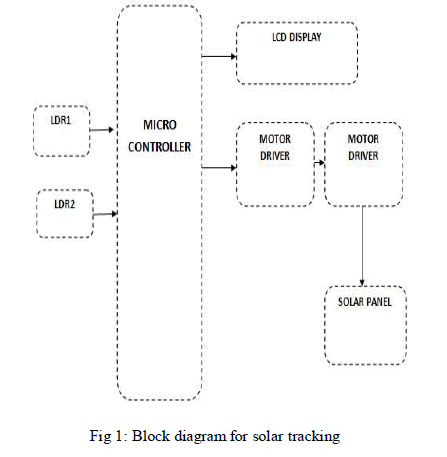 |
| Power optimization is done by using LDR. If the surrounding light is less then LDR reads maximum. According to the value of LDR the ADC shows the reading. The ADC will send this value to microcontroller. According to the value sent by the ADC the microcontroller glows the LED through relay. If the intensity of the light is more means all the LED array will be OFF. Depending upon the intensity of the light LED arrays will be switched ON or OFF. 3.2 Power Supply: The input to the circuit is applied from the regulated power supply [6]. The AC input i.e., 230V from the |
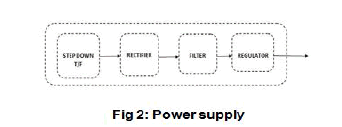 |
| mains supply is step down by the transformer to 12V and is fed to a rectifier. The output obtained from the rectifier is a pulsating DC voltage. So in order to get a pure DC voltage, the output voltage from the rectifier is fed to a filter to remove any AC components present even after rectification. Now, this voltage is given to a voltage regulator to obtain a pure constant DC voltage. 3.3. Coin Based Mobile Charger The basic block diagram of the coin based mobile charger is shown in fig.3 3.3.1. Input Stage The mobile battery charger starts charging a mobile connected to it, when a coin is inserted at the coin insertion slot at the input stage. The type of coin and the size will be displayed at the LCD display for the user, so as to ensure correct coin insertion. Any other coin, if inserted in the slot will be returned to refund box. A mechanical slot is attached with electrical triggering in coin insertion slot, if the correct coin is inserted; it sends a pulse to the control unit authorizing the start of charging the mobile battery connected to the device. Then the coin insertion slot accepts the coin into the battery charging unit and start charging the mobile battery for a specific period controlled by the software of the microcontroller [1]. |
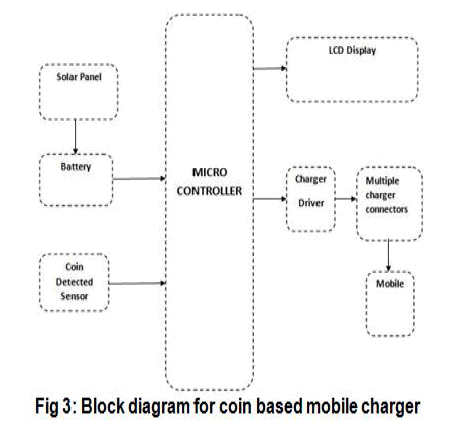 |
| 3.3.2. Controller This section acts according to the input signal from the sensor circuit. Coin accepted or rejected is based on the diameter of the coin. This invokes microcontroller along with LCD interface displays the selection of mobile option if particular mobile is selected for charging the corresponding routine is activated and charge the mobile for a particular duration of time .When the routine completes, it indicates charge complete message through LCD display. Similarly the same procedure is followed for charging more than four different mobiles simultaneously [1] .The simple routine is indicated through flowchart as shown in the Fig 4. |
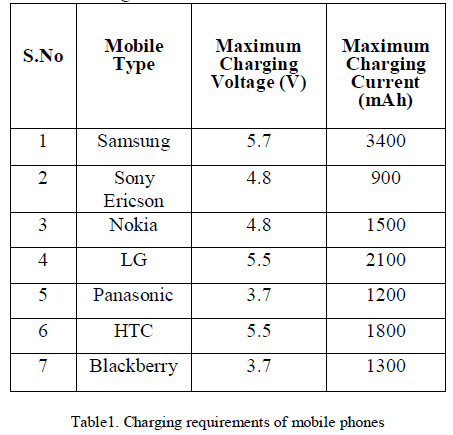 |
| 3.3.3 Output and Display The LCD displays all the information to the customer as and when required. When the mobile battery is connected, it displays” Insert Coin”. While charging it displays “Charging” and at the end of charging cycle it displays “Charge completed”. For charging continuously the coin has to be inserted when the display shows “Charge Completed” The output has 10 terminals for connecting different types of mobile batteries [7] and 7 of them are internally connected for charging mobile batteries of different make as shown in Table 1 [1]. 3.3.4. Power The salient feature of the universal mobile battery charger is that it draws power from the solar energy during the day time for charging the internal battery of the controller. Only if additional power is required, then the grid power is used. A solar micro inverter [8],[9] has been designed for supplying 230v, 50Hz so that both grid power and the solar power are connected in parallel with a switch to changeover from one to the other. |
IV. EXPERIMENTAL RESULTS |
| The hardware setup for coin based mobile charger using solar tracking system shown below in figure 5. This setup contains following hardware parts LDR 1 LDR 2 ATMEL 89C51 micro controller Stepper motor LCD display Motor driver Solar panel Battery Coin detected IR sensor Power supply unit |
| 4.1 Advantages: Effectively receive maximum energy from sun towards earth rotation More useful to save energy from sun and intelligent tracking solar energy Simple and hand efficient Less expensive Reduced man power Low power consumption |
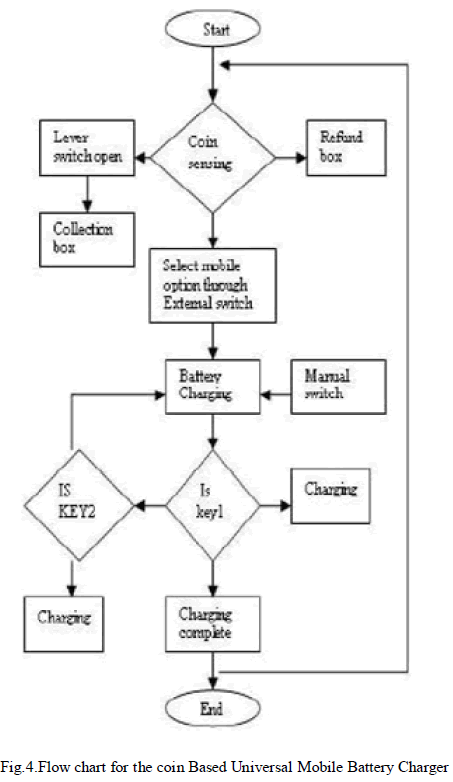 |
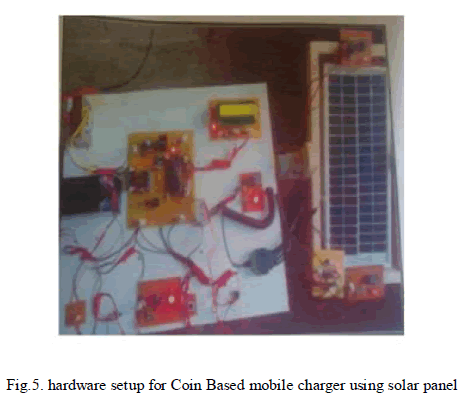 |
| 4.2 Applications: Solar Systems Power Management systems Industrial applications The coin based mobile phone charger is very useful to public for using coin to charge for the mobile phone in any places |
V. CONCLUSIONS |
| In this work a novel method of charging mobile batteries of different manufacturer using solar power has been designed for rural and remote areas where the current supply is not at all available all the time. This paper is very useful in today’s life. Because now days the necessity of communication is very important, so every person having cell phone but every time we cannot carry charger with us. When we are going for long travel we may forget to carry cell phone charger. |
References |
|